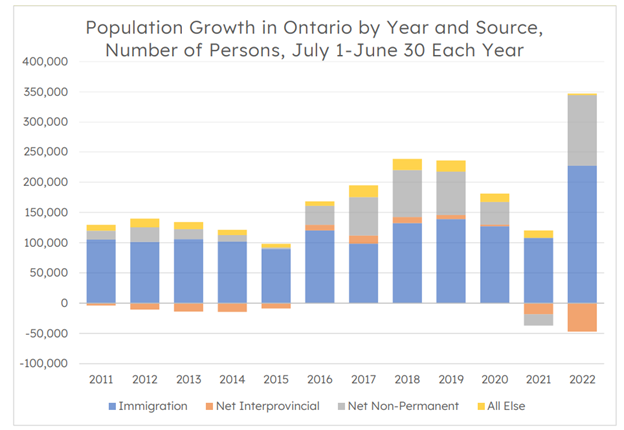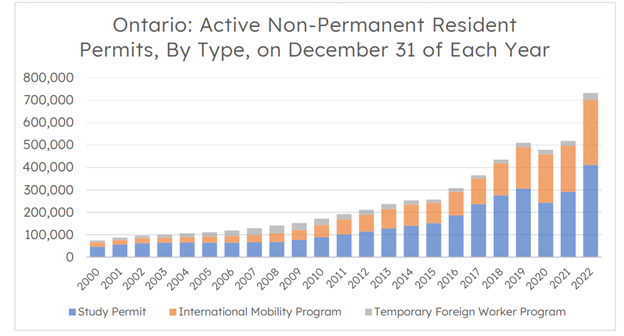Good morning, and welcome back for another year. I’m pretty excited for the next few months. Let me take you through how things are going to go, both in Canadian postsecondary education and here on the blog.
In an ideal world, the next few months would lead to an all-out push on new investments in scientific research. The buying power of national investments in research – which were still pretty good as recently as 15 years ago – are now far from world-class. The investments made in the aftermath of the Fundamental Science Review have been mostly eaten up by inflation. It’s past time the government got serious about this.
But instead as a country we’re going to be talking about something else non-stop for the next few months: housing. You very likely noticed that rental prices are out of control in much of the country. Here’s a quick look at real (i.e. after inflation) price increases for 1-bedroom apartments across Canada since September 2021.
Figure 1: 1- and 2-year real increases in rent for 1-bedroom apartments, selected Canadian cities, 2023

It’s clear that a lot of this has to do with a long-term lack of new construction combined with a sudden of influx of immigration once COVID controls were lifted. Here, courtesy of the Smart Prosperity Institute, are the figures for net population growth in Ontario. In 2022 the size of the annual intake of new Canadians was a little under twice the average from 2016-2020 and three times what it was from 2011 to 2015.
Figure 2: Net Population Growth in Ontario by Year and Source, Number of persons, July 1- to June 30

But look specifically at that grey area, the “net non-permanent” residents. That’s the part that has been grew most quickly in 2022, at about 5 times the pre-2016 average.
Let’s look at how those numbers have gone up in Ontario (again, courtesy of Smart Prosperity). Figure 3 shows data on total permits rather than net ones, which is why the scale looks a bit different than the previous figure. But Lord Thundering Jesus, look at those student visa numbers in blue. And those International Mobility Program figures in Orange? Those are a function of student visa numbers, too, because most of that is former students on post-graduate work visas.
Figure 3: Active Non-Permanent Residents by Type, Ontario, 2000-2022.

We can argue a little bit about the extent to which increased international student numbers are driving the rent increases that are affecting large numbers of renters across the country – especially in the GTA – but the idea that institutions are blameless is nonsense. Yes, things would be better if we had more housing and that’s where the focus should be: but for the foreseeable future we don’t have that housing and so to most people outside postsecondary, what institutions are doing by continuing to increase international student numbers seems indistinguishable from pouring gasoline on a fire. We have met the enemy, and for the most part it is Ontario colleges.
This issue is now consuming the federal government’s agenda, in no small part because the discontent associated with rising rents in parts of BC, Ontario, and Nova Scotia pose a serious risk to Liberals’ re-election hopes. The chief idea the feds have is to impose some kind of “cap” on student visas, which sounds good in theory but is utter nonsense in practice. Once you put a cap on, you must figure out how to ration spots. If you want to know how silly things are getting in Ottawa, there are genuine proposals in which the Immigration Ministry is going to set up some system of distinguishing “good” institutions from “bad” ones or – even more hilariously – where IRCC will rank institutions based on their plans/availability for student housing. This is a nightmare that doesn’t even bear thinking about.
Sick of hearing about housing yet? Well, to quote the towering Prairie poet Randy Bachman, you ain’t seen nothing yet. It’s going to be like this all the way to the budget. And it’s going to drown out every other PSE policy issue. I warned you, remember? And now it’s happening.
Anyways, apart from that, what can we expect over the next little while? Well, an October election in Manitoba could be fun. It’s not impossible that a few pieces on research make it into the budget, but it’s equally not impossible that the federal program review about to be undertaken by Treasury Board Minister Anita Anand might put a couple of PSE-related programs on the chopping block. In Ontario, the Bule Ribbon Panel has submitted its report to government on the adequacy and stability of postsecondary funding. My bet is that both it and the government’s report are published on the Friday before Thanksgiving at 4:30PM, but who knows, it might still make enough of a splash that the Ontario government is forced to act (it’s the second year of a government’s second mandate: occasionally, good public policy emerges unexpectedly when an election’s not on the horizon). Oh, and on January 1st, l’Université de l’Ontario français comes off the federal payroll and reverts to being a provincial responsibility. With domestic enrolments still in double digits and the funding agreement still worth $14 million per year, I think we can expect some rapid policy moves between now and then.
But let’s not confine ourselves to Canada. I think there are some interesting things happening internationally, which we’ll be covering mainly on our Thursday podcasts. Youth populations are plummeting in East Asia but skyrocketing in Central Asia. This, and combined with what is (IMHO) the imminent disappearance of the entity we’ve known for centuries as “Russia” and what seems like an approaching implosion of the Chinese economy, will lead to very different geopolitics of higher education in Asia. There are lots of exciting developments in Latin America and Africa to review. The effects of the June Supreme Court decision, in which it turned out that the Fourteenth Amendment is about protecting white people, will continue to reverberate in the US. Listen in on Thursdays to hear more about this.
Maybe the biggest issue of the day is Artificial Intelligence and how Large Language Models are changing policy and practice in higher education institutions. To help track the development of institutional policy in Canada, we at HESA Towers have put together an AI Observatory to help Canadian institutions share experience and ideas on policy development with respect to AI in the sector. We are also hosting (with colleagues from various institutions) a monthly roundtable to encourage institutional idea-sharing. You can catch our roundtable meeting from last week here and you can sign up for our next one in September here.
(And on top of all that, HESA is going to be rolling out a variety of new products and services this year. Keep an eye out.)
In other words, it’s going to be busy. The sector is probably going to be playing defense most of the time – but maybe that might finally provide the necessary impetus to revise lobbying strategies that haven’t really been working for a decade or so now and come up with some newer and more positive ones. And at some universities, I think things might get quite ugly in the next twelve months. But the hour is always darkest just before the dawn.
Onwards!

 Tweet this post
Tweet this post
